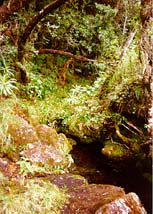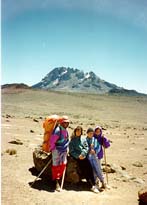

"As wide as all the world, great, high, and unbelievably white in the sun, was the square top of Mount Kilimanjaro" Ernest Hemingway
The first written reference to Mt. Kilimanjaro was by Ptolemy but even
so, Africa's highest mountain and the highest free standing mountain in
 the world remained relatively unknown to the outside world until 1848.
Snow capped and shrouded by clouds, the local Chagga people called it 'Kilema
Kyaro' meaning 'that which cannot be conquered' or 'that which makes a
journey impossible.' Today, it is the dream of every adventurer to conquer
its summit and stand on the "roof of Africa."
the world remained relatively unknown to the outside world until 1848.
Snow capped and shrouded by clouds, the local Chagga people called it 'Kilema
Kyaro' meaning 'that which cannot be conquered' or 'that which makes a
journey impossible.' Today, it is the dream of every adventurer to conquer
its summit and stand on the "roof of Africa."
There are five main routes to the top -- Marangu, Shira, Mweka, Umbwe and Machame. The most popular route is the Marangu Route which starts at the Marangu Gate at 6000 ft. and has huts and facilities along the way. The other routes are more scenic with stunning views of the glaciers. They are also more challenging for the advanced trekker, requiring special permission and the use of tents. Regardless of the route taken, the vistas are magnificent and the flora and fauna of the different life zones are fascinating. Rain forests give way to moorlands and alpine meadows until these, too, give way to an alpine desert where lichens cling tenuously to rocks. The landscape, though desolate, is hauntingly beautiful as you walk among the clouds.
The mountain consists of three volcanoes: Shira, Mawenzi and Kibo. Shira became extinct and collapsed leaving a series of rocky ridges on the Shira plateau. Mawenzi is dormant and its jagged peaks require a technical climb. Uhuru Peak, (19,340 ft.) is Kibo's highest peak but one is considered to have "conquered" the mountain by reaching Gillman's Point at 18,635 ft.
Best Times to Go: January, February and September. These are the drier months and there are fewer hikers.
Getting There: From Europe, KLM flies directly to Kilimanjaro International Airport. It is easier to pre-arrange for airport transfers because most flights arrive at night. Overland, buses are available from Nairobi, Dar-es-Salaam and Mombasa via Tanga.

Clothing/Gear: Comfortable clothing will suffice for the first two days. However, many underestimate the frigid conditions of the mountain above 12,000 feet. Warm clothing is essential and should include a down-filled parka with hood, fleece shirts, warm pants, waterproof and windproof shell pants, thermal underwear, mittens, wool hat or balaklava and scarf. Good walking shoes and socks are appropriate to about 15,000 feet but sturdy hiking boots with warm socks and sock liners are needed to challenge the summit. At this altitude sun protection is necessary so bring snow goggles, dark glasses, suntan lotion and a hat with a brim to protect your face and neck. Also necessary are your water bottle, sleeping bag, trail mix, energy snacks and candy bars, flashlight, camera with film and personal toiletries including toilet paper. None are available past the park gate. It is better to bring your own gear. Equipment can be rented at the Marangu gate but the quality may not be the best and you run the risk of having to use shell pants repaired with electrical duct tape!
General Information: A passport, visa, and yellow fever certificate are required to enter Tanzania. There are exceptions to the visa and vaccination requirements but it is advisable to check with the Tanzanian Embassy for current regulations.
Children ten and under are allowed to climb to Mandara Hut at 8,858 feet. Otherwise, good health and physical fitness are the only requirements for a Kilimanjaro climb.
Costs are very competitive. It is possible to put together your own trek but the savings are hardly worth the effort. If you are on a very tight budget, you can negotiate a climb around the Marangu gate area. You may have to wait until the next day and you need to make sure that park fees are included in the quoted price. Currently, the fees are about $215 for a minimal 5 day climb.
The best value is found with the local outfitters. They will completely organize your trek in advance including the reservations needed for the huts that fill up quickly in the busy season. Also, they use only reliable guides who are not likely to hassle you regarding their tips and you will be provided with "extras" such as a basin of warm water at night and in the morning as well as better food and service. Costs depend on the number of people in your group, the length of the trek and the route to be taken. A full service climb using the Marangu route (five or six day treks) will cost about $120-150 per person per day and includes room and dinner the night before and the night after the climb, park fees, hut fees, guides and porters, all meals while climbing, and transportation to and from the park gate. The other routes usually require at least six days with tents provided and costs about $200 per person per day for a full service climb.Planning Tips:
Important Resources:
Mr. Seamus Brice-Bennett manages the Marangu Hotel which is located on twelve acres of an old coffee estate. The central hotel building was once a farm house and guest accommodation is provided in cottages around the grounds. There is also a nice campsite with water and amenities as well as access to the hotel's facilities. These include a good sized swimming pool, croquet lawn, a restaurant that serves home baked bread and vegetables from its own garden, a bar and well maintained grounds with beautiful flowers and magnificent views of Kilimanjaro.
Besides the full service climbs, the Marangu Hotel offers an alternate arrangement where for about $70 per person, per day the hotel will arrange for a guide and two porters per climber as well as booking hut accommodation. This includes hut fees, park fees, guide and porters, and transportation to and from the park entrance. Climbers bring all their own food and equipment and cater for themselves on the climb. Campsites are available for the nights before and after the climb and cost about $5 per person per night.
The Kibo Hotel still retains an atmosphere of the old Kilimanjaro expeditions at the turn of the century. Old photographs and maps line the walls of the public areas and hint at the grandeur of the place when it was first built. There is also a lovely walled garden that provides fresh cut flowers for the dining tables. Marina Stromvall, the general manager, is a delightful hostess who is sincere in her attempt to provide good service.
The Kibo Hotel is noted for arranging alternate route climbs, especially the Machame route which Marina says is not very difficult. She has made these treks herself and is very knowledgeable about the mountain and East Africa in general.
Related Books:

© copyright 1996 Adventures Great and Small